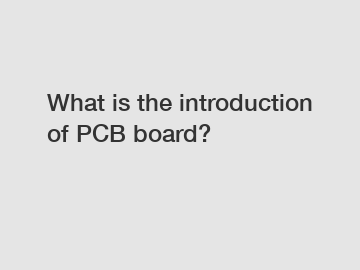What is the introduction of PCB board?
PCB boards are an essential part of almost every electronic device we use today, from smartphones and laptops to household appliances and cars. But what exactly is a PCB board and why is it so important in the world of electronics?
A PCB board, or printed circuit board, is a flat piece of fiberglass or other non-conductive material that holds all the components of an electronic device together. These components are connected to the PCB board using copper traces that run through the board like a network of wires, allowing electricity to flow between them and power the device.
One of the key advantages of PCB boards is their durability and reliability. Because all the components are securely soldered onto the board, there is less risk of them coming loose or failing, even in harsh environmental conditions. This makes PCB boards ideal for use in high-tech devices like smartphones and computers, which need to be able to withstand a lot of wear and tear.

Another advantage of PCB boards is their compact size. Because all the components are mounted on a single board, electronic devices can be made smaller and lighter than would be possible with traditional wiring methods. This is why PCB boards are used in everything from tiny medical devices to large industrial machines.
In addition to their durability and compact size, PCB boards are also highly customizable. Designers can easily change the layout of the components on the board to fit the specific needs of a device, making it possible to create highly specialized and efficient electronics.
The design process for a PCB board starts with a schematic, which is a diagram that shows how all the components will be connected together. Once the schematic is finalized, it is converted into a layout that shows the exact placement of each component on the board. This layout is then used to create a prototype of the PCB board, which is tested to ensure that all the components are connected correctly and the board functions as intended.
Once the prototype has been approved, the final PCB board is manufactured using a process called photoengraving. This involves coating the board with a layer of light-sensitive material and using a UV light to expose the layout onto the board. The board is then etched with a chemical solution that removes the exposed copper, leaving behind the copper traces that connect the components.
After the copper traces have been etched onto the board, the components are soldered into place using a wave soldering machine or a reflow oven. Once all the components have been soldered onto the board, it is inspected for any defects and tested to ensure that it functions correctly. If everything is in order, the PCB board is ready to be installed into the electronic device.
Overall, PCB boards play a crucial role in the world of electronics, making it possible to create smaller, more reliable, and more advanced devices than ever before. With their durability, compact size, and customization options, PCB boards are sure to remain a staple of the electronics industry for years to come.
Are you interested in learning more about automotive pcb design , hasl lead free, Industrial Control PCB Manufacturer? Contact us today to secure an expert consultation!

Comments